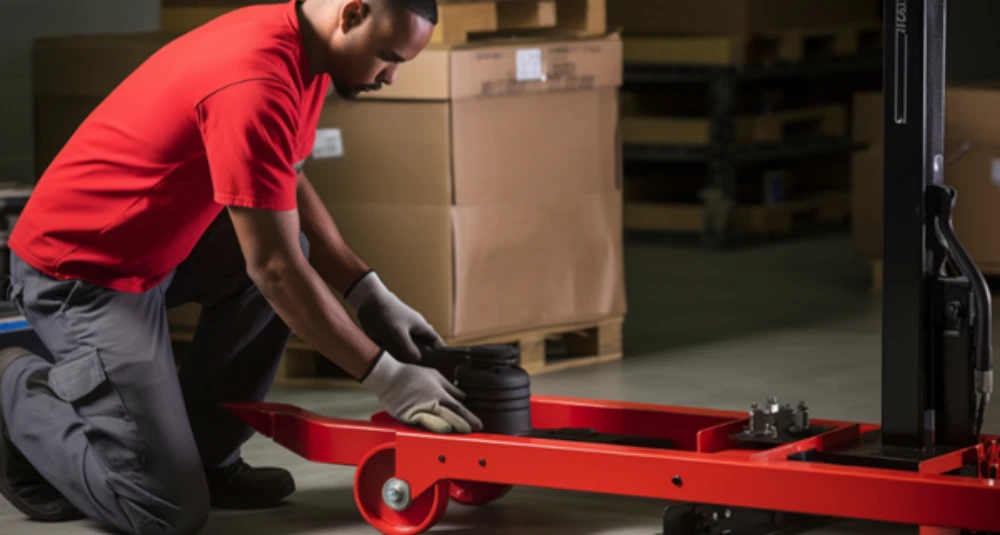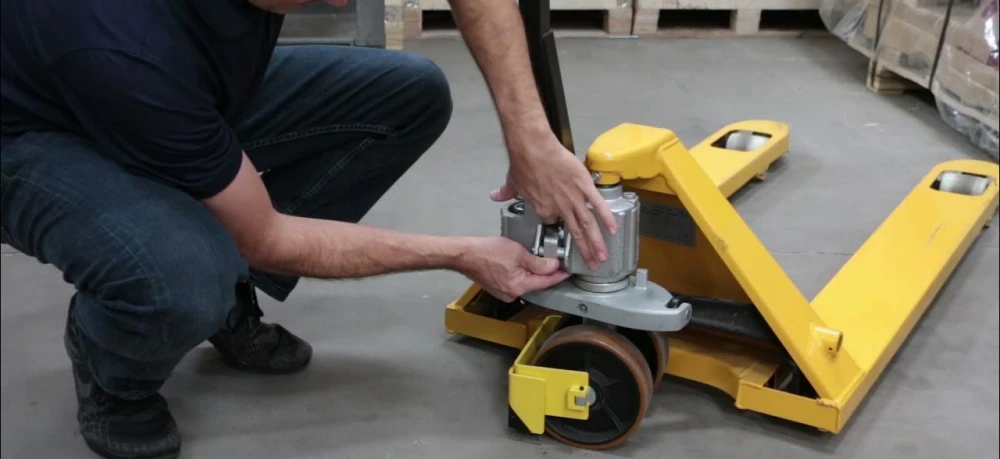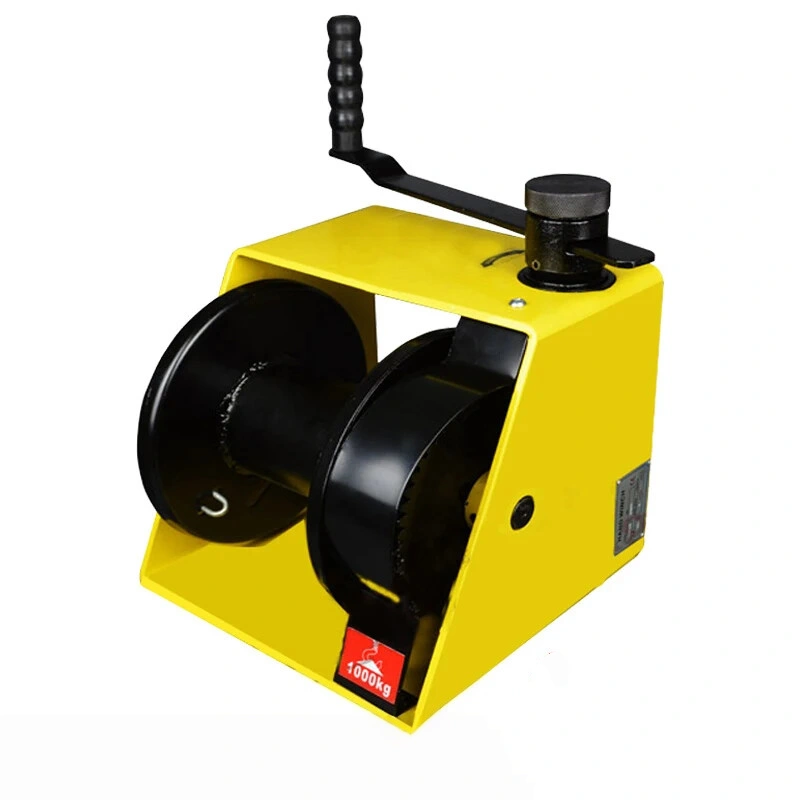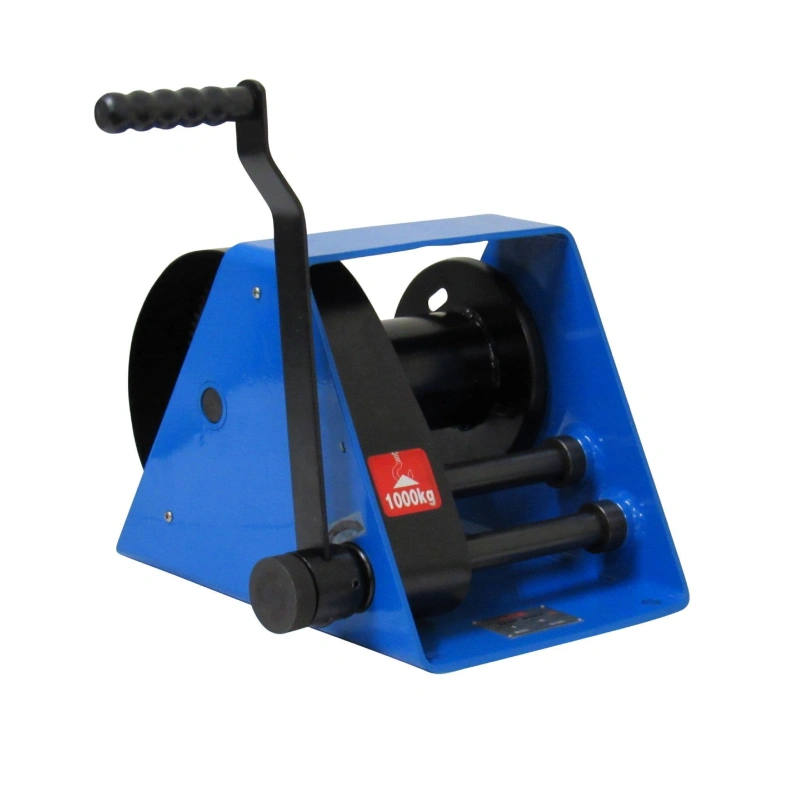You can keep your workplace safe and efficient by using a pallet truck inspection checklist every day. Regular inspections help you spot hazards like back injuries, slips and falls, or broken bones, which are common in warehouse settings.
The hand pallet truck from Powerful Machinery stands out with reliable features such as ergonomic handles, PU wheels, and overload protection. When you inspect your truck, you reduce the risk of collapse and improve load stability. The table below shows how injuries and efficiency improve with consistent checks.
Injury Type | Description |
|---|---|
Back Injuries | Manual handling, improper lifting |
Cuts & Abrasions | Splintered pallets, dislodged nails |
Slip & Falls | Wet spills, debris, tripping risks |
Broken Bones | Falling pallets, ignored safety protocols |
Injury Rate | 4.8 per 100 employees in warehousing |
Safety Benefit | Impact |
|---|---|
Reduced Risk of Collapse | Minimizes injuries and product damage |
Improved Load Stability | Enhances safe transport |
Fewer Broken Pallets | Decreases workplace hazards |
Start each day by following your inspection checklist. Powerful Machinery’s commitment to quality means you can trust your equipment to perform reliably and safely.
Key Takeaways
Use a pallet truck inspection checklist daily to enhance workplace safety and efficiency.
Regular inspections help identify hazards early, reducing the risk of accidents and injuries.
Follow a systematic inspection process to check the frame, wheels, hydraulic system, and safety features.
Document all inspections and maintenance activities to ensure compliance with safety regulations.
Perform routine maintenance to extend the lifespan of your pallet truck and save on repair costs.
Pallet Truck Inspection Checklist Essentials

A thorough pallet truck inspection checklist helps you maintain safety, efficiency, and compliance in your workplace. Powerful Machinery’s hand pallet truck features high-strength welded frames, ergonomic handles, PU wheels, and overload protection. You can use this checklist to guide your daily inspections and prevent costly downtime.
Visual and Structural Checks
Start your inspection by examining the overall condition of your pallet truck. Look for cracks, bends, or deformations in the frame, especially at weld joints and stress points.
Corrosion can weaken the structure, so check for rust or flaking paint. Inspect the fork assembly for any bending or damage caused by overloading or impacts. If you find minor bends, repair them promptly. Replace severely damaged forks to maintain safety.
Tip: Pay close attention to welds and stress points. Small cracks can grow quickly under heavy loads.
Inspection Area | Description | Action Required |
|---|---|---|
Frame | Cracks, bends, corrosion, especially at welds and stress points | Repair small cracks; seek professional help for extensive damage |
Fork Assembly | Bending, warping, or impact damage | Repair minor bends; replace if severely damaged |
Wheels and Forks
Wheels and forks play a critical role in maneuverability and load stability. Inspect drive wheels, load wheels, and caster wheels for cracks, flat spots, excessive wear, or debris in the treads.
Check wheel bearings for unusual noise or excessive play. Make sure axles and axle pins are secure and undamaged. Examine the forks for cracks, bends, or excessive wear. Fork tips should not be bent or damaged.
Inspection Step | Condition Check |
|---|---|
Forks | No cracks, bends, or excessive wear |
Fork tips | Not bent or damaged |
Drive wheel | No cracks, flat spots, or excessive wear |
Load wheels | No cracks, flat spots, or excessive wear |
Caster wheels | Good condition |
Wheel bearings | No unusual noise or excessive play |
Axles and axle pins | Secure, no damage |
Damaged wheels or forks can make steering difficult and cause unstable transport. Uneven wear may lead to load shifting and increased strain on other components. Reinforced forks and proper alignment are essential for reliable performance.
Forks endure stress and wear, especially with heavy loads.
Misaligned forks increase wear and reduce stability.
Clean wheels and forks regularly to prevent debris buildup.
Hydraulic System and Handle
The hydraulic system and handle are vital for lifting and maneuvering loads. Inspect the hydraulic cylinder for leaks, damaged seals, or loose joints. Test the lifting and lowering controls for smooth operation.
If the forks cannot be lowered properly, you may have too much oil or damaged parts. Slow response or vibration can indicate worn-out components.
Check the handle for ergonomic grip and adequate length. Make sure the steering tiller responds easily and the braking system works reliably. Controls should be easily reachable and operate smoothly. Look for accessible load release levers and visible load capacity indicators.
Note: Regular maintenance of the hydraulic system prevents sudden failures and ensures safe lifting.
Indicator | Description |
|---|---|
Forks Can’t Be Lowered Properly | May indicate excess oil or damaged hydraulic parts |
Leaking Hydraulic Oil | Damaged seals or loose joints |
Unstable Transportation Of Loads | Wheel damage or overloading |
Test the handle for smooth, precise control.
Confirm the presence of emergency stop buttons and stability features.
Train operators to use controls correctly.
Safety Features and Labels
Safety features and clear labels are essential for accident prevention. Verify that load limits are visible and not exceeded. Distribute loads evenly to maintain stability. Operate the pallet truck only on level surfaces and stay alert in crowded areas. Regularly check the brake system for safe operation.
Park in designated areas and lower the forks to prevent hazards.
Wear appropriate personal protective equipment (PPE) and assess your surroundings before moving loads. Safety labels communicate risks and guide proper handling, reducing accidents and improving efficiency.
Safety labels enhance awareness and prevent errors.
Clear labeling helps you identify and manage items confidently.
Visual communication improves workflow and minimizes disruptions.
Use the pallet truck inspection checklist every day to keep your equipment in top condition. Powerful Machinery’s hand pallet truck offers the reliability and safety features you need for professional material handling.
Why Inspections Matter for Safety and Compliance?

Operator and Workplace Safety
You protect yourself and your team when you inspect your pallet truck before each shift. Regular checks help you spot problems like damaged wheels, faulty hydraulics, or worn forks. These issues can cause accidents, including fractures or even fatalities.
OSHA reports show that pallet jacks have caused serious injuries, such as broken bones and amputations. You can avoid these risks by following a daily inspection routine.
Tip: Always check pallets and racking units for damage before loading. Dispose of broken pallets right away.
A safe work environment depends on your attention to detail. You maintain safety by identifying equipment malfunctions early and following safety protocols. This approach reduces the chance of accidents and keeps everyone safe.
Evidence Type | Description |
|---|---|
Safety Compliance | Regular inspections ensure pallet trucks are safe and fit for use. |
Proactive Safety | Inspections foster a proactive safety culture and prevent workplace incidents. |
Regulatory Compliance
You must meet strict regulations when operating material handling equipment. Inspection protocols help you comply with standards set by organizations like OSHA. These rules require you to check equipment daily and keep records of each inspection. You reduce risks and avoid legal issues by following these guidelines.
Regulation | Description |
|---|---|
CFR 1910.176(b) | Storage of materials must not create hazards and must be stable and secure. |
CFR 1910.178 | Safe forklift operation requires regular inspections and adherence to load capacities. |
CFR 1910.178(o) | Safe loading and unloading practices must be followed, including verifying load weights. |
Frequent inspections help you meet safety regulations and industry standards. You prevent compliance issues and promote a culture of workplace safety.
Reducing Downtime and Costs
You save time and money by using a pallet truck inspection checklist every day. Neglected inspections can lead to unexpected breakdowns, causing operational disruptions and expensive emergency repairs. Regular maintenance helps you spot minor issues before they become major problems.
Preventive maintenance minimizes costly repairs.
Regular servicing extends equipment lifespan.
Proactive inspections reduce unplanned downtime by up to 50%.
You keep your budget predictable and avoid bottlenecks.
You improve reliability and efficiency by addressing issues early. This approach leads to long-term cost savings and keeps your operations running smoothly.
Pre-Operational and Daily Checks
Step-by-Step Inspection Process
You must follow a systematic approach before each shift to ensure your hand pallet truck operates safely and efficiently. Begin with a risk assessment. Evaluate the work area for obstacles, spills, or uneven surfaces. Confirm that the load matches the truck’s rated capacity and that you have the necessary training.
Use the following table to guide your daily inspection routine:
Check Type | Description |
|---|---|
Visual Inspection | Examine the frame for cracks, bends, or corrosion. Inspect forks for damage. |
Wheels and Rollers | Assess for wear, cracks, or debris that could affect movement. |
Hydraulic System Inspection | Check for fluid leaks and verify the hydraulic fluid level. |
Safety Labels and Decals | Ensure all safety labels are intact and easy to read. |
Operational Checks | Test lifting, lowering, steering, and braking functions. |
Post-Operational Inspection | Clean the truck and document any issues found during use. |
Documentation | Record findings in a maintenance logbook for future reference. |
Follow these steps for a thorough inspection:
Assess the environment and load.
Conduct a visual inspection of the frame and forks.
Check wheels and rollers for damage.
Inspect the hydraulic system for leaks.
Verify safety labels and decals.
Test all operational controls.
Clean the truck after use and record any issues.
Powerful Machinery’s hand pallet truck features an ergonomic handle, overload protection, and PU wheels. These features make your inspection routine more effective and help you catch problems early. Regular checks extend equipment life and reduce downtime.
Tip: Always park the pallet truck in a designated area with forks lowered after use.
What to Do If Issues Are Found?
If you discover any problems during your inspection, act immediately to maintain safety. Report issues to your supervisor, safety manager, or maintenance team using the designated forms or digital platform. Remove the truck from service until qualified personnel complete repairs.
Never attempt quick fixes yourself. After repairs, inspect the truck again to confirm the issue is resolved.
Report problems as soon as you notice them.
Inform the appropriate team of repairs.
Use official reporting methods for documentation.
Remove unsafe equipment from service.
Only allow qualified personnel to perform repairs.
Conduct a follow-up inspection after repairs.
A consistent pallet truck inspection checklist helps you maintain compliance, prevent accidents, and keep your operations running smoothly.
Periodic Maintenance and Record-Keeping

Weekly and Monthly Maintenance
You keep your hand pallet truck in top condition by following a regular maintenance schedule. Weekly and monthly tasks go beyond daily checks and help you catch issues before they become serious. Here’s how you can maintain your Powerful Machinery hand pallet truck:
Weekly Maintenance Tasks:
Grease all moving parts, including axles, wheels, and pivot joints, to reduce friction.
Check the hydraulic oil level and top up if needed.
Measure fork heights and realign them if necessary.
Monthly Maintenance Tasks:
Perform a deep cleaning to spot hidden damage.
Inspect bearings and rollers for play or noise. Replace them if you find problems.
Test the truck under load to ensure smooth operation.
Check the frame and push-rods for proper adjustment.
Tip: Use the maintenance table below to track your schedule.
Maintenance Task | Frequency |
|---|---|
Grease moving parts | Weekly |
Hydraulic oil check | Weekly |
Deep cleaning | Monthly |
Bearing/roller inspection | Monthly |
Operational load test | Monthly |
Inspection Documentation
Accurate documentation helps you meet safety and compliance standards. You should organize your records so you can access them quickly during audits or reviews. Use digital tools or logbooks to record each inspection and maintenance activity.
Write objective and concise reports. Include both positive and negative findings.
Take photos and annotate them for a complete record.
Document non-compliances, hazards, and areas for improvement.
List good practices that can be shared with your team.
Organize reports into sections: Summary, Findings, Recommendations, and Corrective Actions.
Use clear naming conventions and keep your records indexed for easy retrieval.
Note: Regularly review and update your documentation to stay aligned with industry regulations.
Addressing Common Issues
You can prevent costly repairs by identifying and fixing common issues early. Regular inspections help you spot problems like hydraulic leaks, worn wheels, or bent forks.
Inspection Area | Common Issues | Recommended Actions |
|---|---|---|
Steer wheels | High wear, peeling polyurethane | Inspect and replace if needed |
Load rollers | Flat spots, cracks, chipping | Inspect and replace if needed |
All wheels | Lodged debris | Clean and inspect for damage |
Hydraulic system | Leakage, weak lifting | Replace seals, refill oil |
Forks | Bending or breakage | Repair or replace |
Handle | Control failure | Lubricate or replace components |
Regular maintenance and prompt repairs keep your Powerful Machinery hand pallet truck safe, reliable, and ready for daily use.
Conclusion
You gain long-term safety and efficiency when you use a pallet truck inspection checklist every day. Regular checks help you spot problems early, prevent costly breakdowns, and keep your equipment in top shape.
You reduce the risk of accidents and improve operational efficiency.
Routine maintenance extends the lifespan of your hand pallet truck and saves money over time.
Powerful Machinery stands behind every product with a commitment to quality and reliability. For tailored solutions or more resources, visit Powerful Machinery.
FAQ
How often should you inspect your hand pallet truck?
You should inspect your hand pallet truck before every shift. Daily checks help you catch problems early and keep your equipment safe. Schedule weekly and monthly maintenance for deeper inspections.
What should you do if you find a hydraulic leak?
Stop using the pallet truck immediately. Report the issue to your supervisor or maintenance team. Only qualified personnel should repair hydraulic leaks. Always confirm the repair before returning the truck to service.
Can you use a hand pallet truck on ramps?
You can use a hand pallet truck on ramps if the surface is smooth and the load is balanced. Move slowly and avoid overloading. Always check the ramp for debris or damage before use.
How do you extend the lifespan of your pallet truck?
Clean the truck after each use.
Lubricate moving parts weekly.
Avoid overloading.
Store in a dry, designated area.
Inspect regularly for wear and damage.
Where can you find more resources or support?
Resource Type | How to Access |
|---|---|
Product Manuals | Visit Powerful Machinery’s website |
Technical Support | Contact customer service online |
Custom Solutions | Request a consultation via the website |


